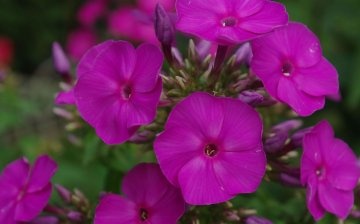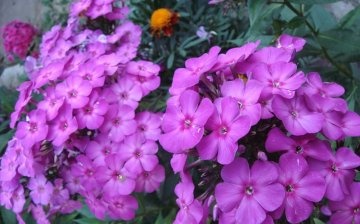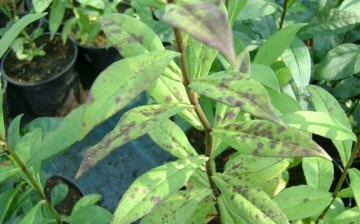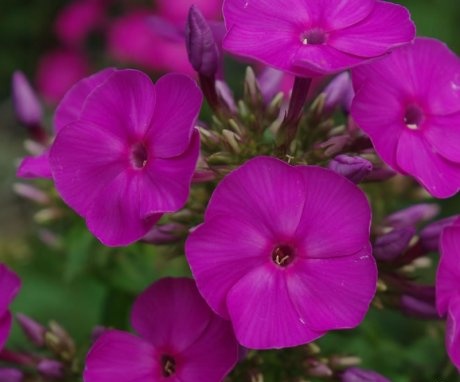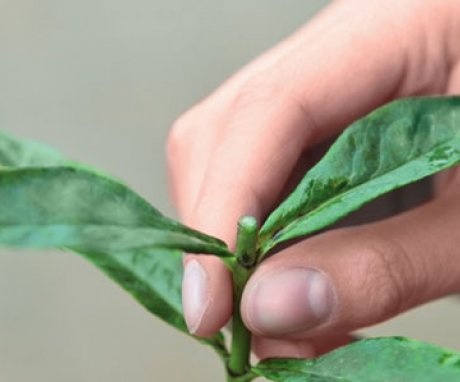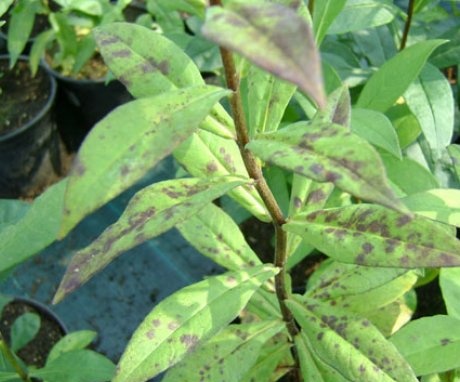Phlox Amethyst - a beautiful perennial for the garden
Phlox are the favorite flowers of many gardeners. They are bright, beautiful, take root well, easily tolerate wintering and are combined with almost any other flowers in the flower bed. Phlox Amethyst has earned special respect due to its unpretentiousness, endurance and high decorative qualities. Growing phlox is recommended for novice gardeners who are afraid not to cope with more capricious plants.
Content:
- Description and application in the garden
- Reproduction and planting
- Care Tips
- Phlox diseases and pests
Description and application in the garden
Phlox have long become popular in gardens, parks, flower beds, in front gardens. These are beautifully flowering, low flowers, the name of which is translated as "flame". Phlox buds are brightly colored. They bloom 1 time per season, the color lasts quite a long time (1.5-2 months).
Phlox Amethyst belongs to the group of paniculata. Its small flowers are collected at the top in the form of an elongated inflorescence. The flowers are funnel-shaped, the petals are strongly open and bent 90 degrees to the funnel. Phlox color Amethyst is blue-lilac, lilac with a pinkish tinge. Flowers are five-petal medium-sized. Plant height reaches 1 m. Inflorescences are rather large, bright, fragrant. Phlox always stands out in the garden with its color. The flower retains its brightness constantly, without fading in the sun.
Phlox Amethyst is considered one of the most frost-resistant and resistant to adverse environmental conditions.
The most minimal and standard care is required. Phloxes are surrounded by legends. For a long time they have been endowed with magical powers. There is a legend according to which Odysseus and his companions, going down to Hades, lit their way with torches. Having got to the surface, the sailors threw torches on the ground, and beautiful bright flowers grew from them. Purple phlox Amethyst are considered to be the helpers of all lovers. To refresh the senses, just put a purple flower on the pillow of your beloved or loved one. Also lilac-lilac phlox help creative people to reveal their potential, find inspiration and believe in their own strengths. Some traditional healers believe that a decoction of phlox is good for both the spirit and the body. To do this, you need to brew dried flowers and drink a teaspoon of broth a day.
As a rule, phlox are used for decorative purposes to decorate the garden, flower beds, front gardens. They are planted separately or create compositions. Phlox go well with irises, asters, bells, snapdragon, coniferous bushes. However, when creating compositions, gardeners must take into account not only the appearance, color of flowers, but also the period of their flowering, so that it does not happen that the flowers in the flower bed bloom in turn. The flowering period of phlox Amethyst is mid-summer-September. Phlox grow well and take root quickly, they can be used as a lawn, a living border, to decorate gazebos, flower beds, front gardens, verandas.
Reproduction and planting
Reproduction of phlox is quite easy. To plant this flower on your site, you can buy the seeds, ask them (or a stalk, 1 flower with a root) from the neighbors. The planting and breeding process is simple. There are several ways to breed phlox. You can choose any method that is the most accessible or understandable.
Phloxes take root well and grow on any soil, but they especially like light ones with a small amount of clay.
Breeding methods:
- Dividing the bush... One of the easiest phlox breeding methods. You can choose almost any time, but for better survival it is better not to divide the bush in late autumn, since by the first frost it will not have time to take root. For dividing, we choose an adult bush (5-6 years old), carefully dig it out and begin to divide it. It is advisable to separate the stems and roots with your hands, but a sharp knife can also be used. We divide the flowers in such a way that each stem has a small bunch of roots. We plant the resulting cuttings in a prepared place, after which each of them grows into an independent bush.
- Reproduction cuttings... Also a simple and affordable way to breed phlox. For this type of breeding, it is better to choose a period before flowering: spring or first half of June. Choose only healthy and sturdy plants for cutting. Prepare the cuttings so that each has 2 nodes. The bottom cut should go directly under the bottom knot and the top cut a couple of cm above the top knot. We cut off the leaves from the lower node completely, and cut the upper ones in half. After that, the cuttings are planted in boxes or directly into the ground. If you plant in boxes, then transplanting into open ground is possible immediately after rooting (after 2-3 weeks).
- Reproduction seeds... Phlox can be propagated by seeds, but it is not always possible to preserve their varietal qualities. Seed boxes are formed in autumn. It is best to cleanse the seeds before the sowing procedure itself. Phlox seeds are not stored for a long time, so they need to be sown in the fall, in the spring the first shoots will appear. In May, when the seedlings are strong enough, you can plant them. It is worth remembering that phlox Amethyst bushes well, so the distance between seedlings should be sufficient (see 20).
Whichever method you choose, plant and plant phloxes best on a cloudy day or in the morning, as the midday sun weakens the plant.
Care Tips
Caring for phlox is quite simple, but following some rules will preserve the beauty and splendor of the flower bed for many years. With proper care, a phlox bush can grow and bloom in the same place for up to 15 years. Care rules:
- You can plant phlox in a sunny place or in partial shade. In the shade, phloxes also bloom, but not so magnificently and for a long time. The sun does not damage the petals and they do not fade.
- If you plant phlox in the spring, prepare a place for them in the fall: dig up the soil, remove all roots and debris weeds.
- Phloxes love regular feeding. If you want to have a lush flower bed, make mineral fertilizers it is necessary constantly throughout the entire growing season (from the appearance of buds to the end of flowering in September).
- Phlox should be watered abundantly, but not often, avoiding waterlogging of the soil. Phloxes do not like stagnant water and start to get sick. Water the flowers as needed if the soil is already dry. You can water more often in dry and very hot weather. It is best to choose for watering in the afternoon, in the afternoon. The soil should always be slightly damp, but not muddy. After watering, it is recommended to loosen the soil a little.
- A flowerbed with phlox needs to be weeded regularly. Weeds not only make the flower bed look unkempt, they damage the flowers, take nutrients from the soil, and tall weeds obscure the flowers.
- Phloxes can grow in one place for a long time, but periodically they need to be rejuvenated (every 3-4 years). For this, the method of dividing the bush described above is used, when the cuttings are planted in a previously prepared new place with fertilized soil. The distance between the flowers during transplantation should be at least half a meter, as they quickly bush.
- Phlox Amethyst should be prepared for winter. For the winter the soil spud and sprinkle with humus to protect the roots from freezing. Sometimes seeds are formed too late and do not have time to ripen before frost.If you want to get seeds and propagate the plant, dig up a couple of bushes, plant in a box, and transfer to a warm room. After the seeds ripen, they can be left until autumn, it is worth remembering that they quickly lose their germination.
- If the winters are snowy, then phlox need not be covered. A sufficient layer of snow will help the plants survive frosts below -30. If there is little snow, it is imperative to cover the phlox, otherwise the roots will freeze.
Phlox diseases and pests
The most common phlox diseases and pests:
- Fomoz. This fungal disease usually affects vegetables, especially potato and cabbage, but in some cases it can be transmitted to colors. Phomosis is also called button rot. The disease manifests itself in the form of spots on the stems and near the nodes. Plants often die. For the fight, special drugs are used.
- Powdery mildew... It is one of the most common fungal plant infections. Powdery mildew is not immediately detectable, as it resembles a thin layer of dust on a plant. It affects leaves and flowers, they dry up and fall off, and new ones grow deformed. White bloom not only interferes with the process of photosynthesis, but also draws nutrients from the plant. To get rid of powdery mildew, you need to cut off all severely affected leaves and stems, and spray the rest fungicidethat also need to saturate the soil.
- Nematodes... These are thin worms that penetrate and feed on plant tissues. Nematodes lay eggs under the skin of the stem, as a result, the stem of the plant is deformed, small swellings are visible on it. The inflorescence appears with small flowers. After a while, the plant dies. It is impossible to cure the affected bushes; they are dug up and burned as far as possible from other garden plants.
- Naked slugs. These garden pests feed on many plants. They love moisture, so they settle where the soil is waterlogged. They do not go out in the sun, but feed at night or on cloudy days. If the summer is rainy, the slugs will actively reproduce. The fight is carried out with the help ash, sodium chloride solution. If there are ditches and ravines nearby where slugs settle, they need to be dried.
- The penny is slobbering. The name of these insects comes from the ability of the larvae to protect themselves with a frothy liquid, similar to saliva. Thus, they protect themselves from other insects. The stump makes punctures on the leaves and stems, sucking the nutrients out of the plant. To combat pennies, it is necessary to use chemicals, as well as monitor the level of humidity.
With proper care, adherence to watering rules and weed removal phloxes get sick very rarely. These plants are quite resistant, but with a lack of moisture or nutrition, they begin to weaken.
More information can be found in the video:




